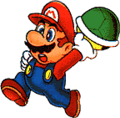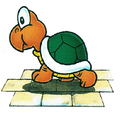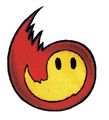Mario Clash
- This article is about the Virtual Boy game. For the microgame from WarioWare, Inc.: Mega Microgame$! with the same name, see Mario Clash (microgame).
| Mario Clash | |||
|---|---|---|---|
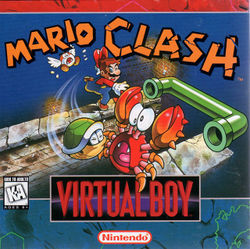 American box art For alternate box art, see the related gallery. | |||
| Developer | Nintendo R&D1 | ||
| Publisher | Nintendo | ||
| Platforms | Virtual Boy, Virtual Boy - Nintendo Classics | ||
| Release dates | Virtual Boy: Virtual Boy - Nintendo Classics: | ||
| Language | English | ||
| Genres | Platformer, action | ||
| Rating |
| ||
| Mode | Single player | ||
| Format | Nintendo Switch: Nintendo Switch 2: Virtual Boy:
| ||
| Input | Nintendo Switch: Nintendo Switch 2: Virtual Boy:
| ||
| Serial code | |||
Mario Clash is a game released for the Virtual Boy in 1995. It is also the first 3D stereoscopic game of the Super Mario franchise. The game is a return to the style of the arcade game Mario Bros., but it is for only one player.
The game will be re-released for the first time on Virtual Boy - Nintendo Classics for the Nintendo Switch and Nintendo Switch 2.
Story[edit]
From the instruction booklet:
The Clash House Tower has been invaded by bad guys! It's up to Mario to clear them out, throwing Koopa shells to knock them away. Take care as you battle in dangerous rooms of narrow ledges connected by pipes.
The game's introduction shows a skull-marked blimp depositing several passengers, implied to be the game's enemies, to an enormously tall tower, followed by a similarly skull-marked flag being raised atop the tower. The scene then pans down to the ground, where Mario enters the door, labeled "Clash Tower" above its entrance.
Gameplay[edit]
Each level consists of two layers, a foreground and a background, that are connected by Warp Pipes. When Mario enters the stage through the rope, he can decide which layer to start in. Each layer may have two floors or floating platforms between the two floors. Later levels have slippery icy platforms.
To beat each level, Mario must knock targeted enemies off the stage before the Time Limit runs out. Stomping on Koopas provides Mario with his only weapon, their shells. There are always two Koopas; if one gets knocked off, another one takes its place. Enemies and thrown Shells can travel through the pipes. Many enemies need to be hit from the side to stun them, thus Mario must throw Shells from the background to the foreground and vice-versa in order to hit them, but a Shell becomes lost if he misses. It is also possible to ricochet off multiple enemies this way. Stunned targets can be dispatched by kicking them or throwing a Shell at them again. However, all stunned enemies can recover, including the Koopa that Mario is holding. Also, the last target of each level moves faster. Stunning a target is worth 100 points, while dispatching one is worth 500. Defeating multiple enemies with a single throw gives bonus points.
The game allows the player to select any of the first 40 levels to start. After the player clears all 99 levels, the game loops back to Level 1, but all the enemies move faster. There is no true ending, but reaching the maximum number of points (999,999) awards the player a cutscene. Between some levels is the Bonus Chance where Mario can collect coins for extra points or get an extra life. The other method of getting extra lives is to accrue enough points. When this is achieved, a 1UP sign flies across the screen. If Mario hits it with a Shell, he gets a second extra life. This sign does not show up if the threshold is crossed during the Bonus Chance. It is also impossible to hit if it appears after Mario defeats the last target. There is no save function, and high scores are not recorded.
Enemies[edit]
| Target | |||
|---|---|---|---|
| Enemy | Name | Debut | Information |
| Spike | Level 1 | Spikes are single-spiked turtles that can be defeated with a single Shell collision from any angle. | |
| Thorny | Level 3 | Thornies are triple-spiked turtles that can be stunned only by hitting their sides. | |
| Para-Goomba | Level 6 | Para-Goombas are slow hopping enemies that can be stunned only by hitting their sides. | |
| Lobb | Level 9 | Lobbs are wheeled tank-like contraptions that throw Iron Balls at Mario strong enough to stop a Shell, and can be stunned only by hitting their sides. | |
| Sidestepper | Level 11 | Sidesteppers are irritable crabs that must be hit in the front or back to damage them and then from the side to defeat them, with them first facing the side, then facing the screen after being hit once. | |
| Snake | Level 13 | Snakes are reptiles that slowly bloat up before spitting a single egg, which hatches into another Snake; the Snakes can be stunned only by hitting their sides, and the eggs are destroyed by any sort of contact from Mario or a Shell. | |
| Big Boo | Level 15 | Big Boos are ghosts that fly in a wavy pattern, occasionally becoming transparent, and can be stunned only by hitting their sides when they are not transparent. | |
| Pokey | Level 17 | Pokeys are three-segmented cacti that can regenerate their lower segments; if just a head, they can be stunned only by hitting their sides, but when one is the final enemy, it moves extremely quickly. | |
| Miscellaneous | |||
| Enemy | Name | Debut | Information |
| Koopa | Level 1 | Koopas are infinitely spawning paired enemies that can be jumped on unlike other enemies, allowing Mario to use their shells as projectiles. | |
| Fire | Level 1 | Fires are spinning fireballs that spawn if Mario stays on the same level too long, moving with a simple wavy pattern, but can be destroyed with a Shell. | |
| Ice | Level 12 | Ices are icicles that spawn from ceilings in icy levels and can be destroyed with a Shell, though they shatter upon hitting the ground anyway. | |
Items[edit]
- Mushroom – After Mario defeats 30 target enemies, a mushroom exits a pipe. Collecting the mushroom initiates Fever Time, a period that makes Mario's throw strong enough to defeat all enemies on contact and doubles points. Losing a Shell or losing a life ends Fever Time.
- Coin – In the Bonus Chance, collecting coins is worth 300 points each, and there is an extra life awarded for collecting all of them.
Cameos[edit]
Cameos from other Super Mario–series characters appear in a Nintendo border after every 100,000 points scored. In the Bonus Chance, Luigi, Princess Toadstool, Yoshi, and Toads appear in the bleachers.
| Score | Cameo | Screenshot |
|---|---|---|
| 100,000 points | Mario saying, "Good!" | 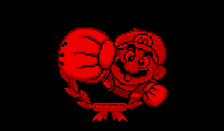
|
| 200,000 points | Toad saying, "Great!" | 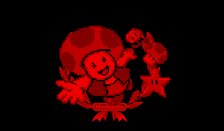
|
| 300,000 points | Yoshi saying, "Wonderful!" | 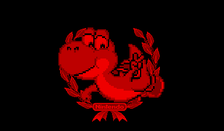
|
| 400,000 points | Luigi saying, "Marvelous!" | 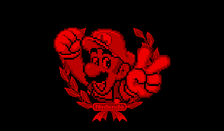
|
| 500,000 points | Wario saying, "Superb!" | 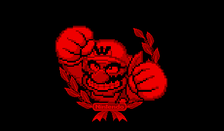
|
| 600,000 points | Princess Toadstool saying, "Fantastic!" | 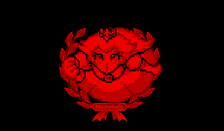
|
| 700,000 points | Bowser saying, "Astonishing!" | 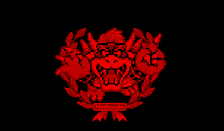
|
| 800,000 points | Donkey Kong and Donkey Kong Jr. saying, "Amazing!" | 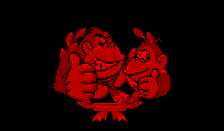
|
| 900,000 points | A group photo of Mario, Luigi, and Toadstool saying, "Incredible!!" | 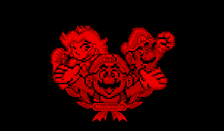
|
| 999,999 points | An enemy cast roll holding white flags under the text "All right, that's it—you win!" | 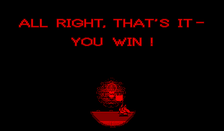
|
Staff[edit]
- Main article: List of Mario Clash staff
Pre-release and unused content[edit]
Mario Clash was originally a minigame[5] in VB Mario Land.[6] The game Mario Bros. VB itself was an earlier version of Mario Clash. It was shown as a demo game at the Shoshinkai expo in Japan, which took place on November 15 and 16, 1994.[7][8] The Electronic Entertainment Expo in May 1995 revealed that the Mario Bros. minigame (which was previously known to be included in the VB Mario Land demo) was now being developed as a standalone game titled Mario Clash, which was planned to be released as a launch title for the Virtual Boy.[9] For unknown reasons, there were no further reports of VB Mario Land being developed.
Reception[edit]
The game received mixed reviews. ScrewAttack named this video game "The second worst Super Mario video game of all time,"[10] while other reviews were more positive. The Video Game Critic gave it an A and called it a "must have for Virtual Boy owners."
Gallery[edit]
- For this subject's image gallery, see Gallery:Mario Clash.
Big Boo, Para-Goomba, Thorny, and Sidestepper
Multimedia[edit]
| File info 0:07 |
| File info |
References in later games[edit]
- A microgame based on Mario Clash appears in 9-Volt's set of microgames.
- The same microgame reappears in 5-Volt's set of microgames.
Names in other languages[edit]
| Language | Name | Meaning | Notes |
|---|---|---|---|
| Japanese | マリオクラッシュ[1] Mario Kurasshu |
Mario Clash |
References[edit]
- ^ a b マリオクラッシュ. Nintendo Co., Ltd. (Japanese). Retrieved January 13, 2025.
- ^ Mario Clash Virtual Boy. IGN. Retrieved June 4, 2025. (Archived October 6, 2008 via Wayback Machine.)
- ^ Nintendo of America (September 12, 2025). Nintendo Direct 9.12.2025. YouTube. Retrieved September 12, 2025.
- ^ American box cover
- ^ Long, Neil et al. (January 2010). The Official Nintendo Magazine Issue 51. EMAP (British English). Page 62.
- ^ March 1995. Nintendo Power issue #70. Nintendo of America (American English). Page 29.
- ^ January 1995. Electronic Gaming Monthly issue 066. American English. Page 89.
- ^ January 1995. Nintendo Power issue #68. Nintendo of America (American English). Page 52.
- ^ July 1995. Total! magazine issue #43. Page 16-17.
- ^ ScrewAttack's Video Game Vault (February 8, 2022). ScrewAttack's Top 10 Worst Mario Games [2007-08-14] (6:25). YouTube. Retrieved October 17, 2024.
| Mario Clash | |
|---|---|
| Characters | Bowser • Donkey Kong • Donkey Kong Jr. • Luigi • Mario • Peach • Toad • Wario • Yoshi |
| Items | Coin • Mushroom |
| Enemies and obstacles | Big Boo • Fire • Ice (terrain) • Ice (falling object) • Koopa • Lobb • Para-Goomba • Pokey • Sidestepper • Snake • Spike • Thorny |
| Miscellaneous | Clash Tower • Gallery • Staff |
| Virtual Boy games | |
|---|---|
| Super Mario franchise | Mario's Tennis (1995) • Mario Clash (1995) • VB Mario Land (canceled) • VB Mario Kart (canceled) |
| Donkey Kong franchise | Unnamed Donkey Kong Country proof-of-concept (tech demo) |
| Wario franchise | Virtual Boy Wario Land (1995) |



